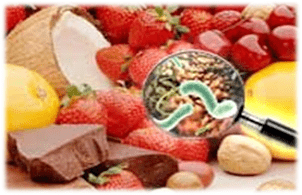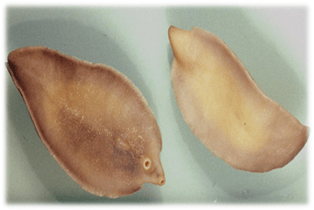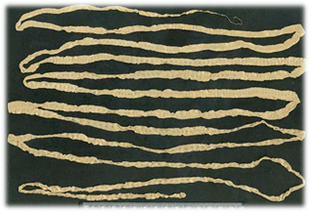There are a huge number of different parasites that can exist in the internal organs of a person or inhabit his skin and hair.Including such parasites can be helminths.
Helminth- The common name of parasitic worms living in the human body, other animals or plants.
According to the World Health Organization statistics, more than 4.5 billion people worldwide are infected with various parasites, many of which are helminths.
Official statistics for the reporting of the Russian Federation have noted an increase in the incidence of major helminths in some territories of the constituent organizations of the Russian Federation, more special: echinococcosis, inventory.In a number of territories, indicators of the frequency of enterobiosis and ascaridosis remain at a high level. There are many ways to enter the human body, but one of the most common ways of infection is infection through food.Poor -washed vegetables, fruits or herbs, insufficient fried or boiled meat, fish, poultry, improperly treated foods can lead to helminth infection.
There are many ways to enter the human body, but one of the most common ways of infection is infection through food.Poor -washed vegetables, fruits or herbs, insufficient fried or boiled meat, fish, poultry, improperly treated foods can lead to helminth infection.
You can become infected in the case of improper storage of the finished product, such as storing sweet sweets without protective packaging can lead to a helminth infection whose eggs can enter the finished product using flies or other insects.
Let's try to understand which helminths are transmitted with food and are most common in our country and how to minimize the risk of infection with them.
Supreme (cat, liver, lancet, etc.)
Fasioolosis
In humans, more than 40 types of subsidists can parasitize, while the location of helminths in the body can be very different - liver, light, blood vessels.
The liver borrower is the causative agent of the fasmolysis and affects the liver and gallbladder.
A person is infected when using vegetable garden crops for watering water from open ponds.
Patients have common symptoms of intoxication - weakness, decreased appetite, nausea, headache.Allergic reactions can occur in the form of itching of the skin or urticaria, asthmatic attacks.
Increasing the size of the parasite can lead to a disruption of the flow of bile in the duodenum and the appearance of signs of mechanical jaundice.Patients have pain in the right hypochondrium.Next, skin jaundice can be observed and the stools can be discolored.
Opistorchoz
The causative agents of Opishorchiasis is a cat saucer.
Human infection occurs when the raw is not sufficiently heat treated or salted fish.
The clinical manifestations of ophorchiasis are characterized by a significant variety.It depends on the individual characteristics of the body, as well as the intensity and duration of the infection.The number of parasitic worms can fluctuate in a large range: from single parasites to several tens and even hundreds.Repeated use of infected fish leads to an increase in infection and worsening clinical manifestations.Clinically, the disease may be accompanied by fever in patients, the appearance of urticaria, itching of the skin, muscles and joint pain.Patients may have pain in the right hypochondrium, a feeling of heaviness in the stomach, nausea.

Paragonism
The main causative agent of paragonimosis in humans is pulmonary bacon.
The causative agent of the disease enters the intestine of a person when eating crustaceans living in areas where there is a focus of the disease and migrates through the body: they penetrate the intestinal wall into the abdominal cavity and then enter the pleural cavity through the diaphragm, then into the lung tissue.Longer larvae can penetrate other organs and tissues.The localization of the parasite in the brain is particularly dangerous.The pulmonary localization of the parasite occurs in one -third of the infected people and is often the cause of death.
In the early stages of the disease, when the lung bacon migrates only throughout the body, the disease is almost asymptomatic.Sometimes small allergic reactions are possible, itching of the skin, less often - abdominal pain, jaundice.As soon as the parasite reaches the final localization, patients pronounce symptoms of lung damage: a constant cough with an abundance of phlegm, severe chest pain.Various complications can occur during the disease, such as pneumothorax - air entering the pleural cavity.Very often pneumonia or pleurisy (inflammation in the pleural cavity) develop in patients.
Red worms
Tape for tape (cestodi) - a group of parasitic worms that have the shape of a ribbon and consist of a different number of anatomically isolated segments - swallowing.The dimensions of the worms range from a few millimeters to 10-15 meters or more.At the anterior end of the worm is the head, which is the organ of fixation of the parasite to the human intestinal mucosa.Helmint is fixed to the intestinal wall with the help of various devices - rounded or cut suction glasses, hooks.
Amrobotriosis
The causative agent of dipylobotriosis is a wide band that lives in a person's gut.
The tape is a wide-ranging length of 12-15 meters or more, and the number of segments of the-theral thousands.

Human infection occurs when thermally treated, freshly frozen, poorly cut, poorly faded and fertilizer, raw fish ground fish, as well as using freshly salted fish.The clinical picture is due to the mechanical effect of helminth on the intestinal mucosa and the absorption of nutrients.Patients with dipylobotriosis complain of pain and roaring in the stomach, nausea, vomiting.There is often a stool disorder.With the simultaneous parasitisation of several worms, an intestinal obstacle may occur.
The tape adsorizes vitamin B12 on its surface and this leads to disruption of red blood cell formation in the patients' body and the onset of anemia.Patients have a pale skin, weakness, malaise.
Tonaryhosis
The causative agent of shading is a bull tapeworm that is localized by the small intestine of a person and can reach a length of 10 meters.
People are infected with tusiarinchosis when eating infected meat from cattle (poor fried or cooked, strings, mince).
Tusirchosis often occurs asymptomatic and is detected accidentally when the patient sees in his upright segment of parasites or finds them in bed or on clothes.During the interrogation, the patient may complain that he has recently experienced weakness, increased fatigue, sleep disturbance, skin of abdomen, pain in the right venerable region, vomiting, disorder of the chair.
As a complication of tusirrhosis in patients, an attack of acute appendicitis or intestinal obstruction may occur.
Teniosis
The causative agent of tiniosis is a pork chain that is located in the small intestine of a person and can reach a length of 3 meters.
Pork tapeworms can be located in different organs and tissues.
Relatively favorable cysticchosis with localization in subcutaneous tissue or skeletal muscles.

Cysticis of the eyes, patients complain of distortion of objects, lacrimation and a gradual decrease in visual acuity.
Cysticis of the brain is difficult and often ends with a fatal result for a sick person.
Echinococcosis
The causative agent of echinococcosis is echinococcus, which is located in the liver and lungs and can reach a length of 5-6 meters.
For a person, an infection with Echinococcus is possible with the use of unwashed garden crops, vegetables or fruits that can be parasitic eggs.
The clinical manifestations of the disease depend on the size, amount of echinococcus bubbles in the patient's body.With the localization of echinococcus in the liver, patients complain about the severity and pain in the correct hypochondrium, as well as the yellowness of the skin as a result of a disturbance of bile drain.The large cysts that drain the vein of the gate lead to a disorder of the outflow of the venous blood from the intestine and the appearance of ascites - the accumulation of fluid in the abdominal cavity.
When localized in the lungs, dry cough and pain during breathing are concerned.
Alvecocosis
The causative agent of alveococcosis is an alveococcus that affects the liver with possible subsequent metastases to various other organs.The size of the alveococcus does not exceed 5 mm.
One is infected when eating unwashed wild herbs and berries, as well as when eating products, washing that is done in an outdoor pond.
In the early stages of the disease, patients are concerned about weakness, malaise, headache, itching of the skin.In the future, complaints of a sense of heaviness in the right hypochondrium may occur;Vomiting, diarrhea, bloating, especially after eating fatty foods.
The patient's condition worsens significantly when Alveococcus enters other organs.The most dangerous metastases in the brain, kidneys, lungs.Against the background of inhibition of the patient's immune system, the bubbles are suppuable very often, there are abscesses in the internal organs that even more become the patient's condition and can be the cause of death.
Roundworms (nematodes)
Round worms are one of the most numerous types of worms.Diseases caused by roundworms are called nematodoses.
The body of the nematode has the form of captured or thread, connections at the edges, rounded in the cross -section, the size of the circle of worms may be different, but more often it does not exceed 0.5 meters.
Acaridosis
The causative agent of ascariasis is ascaris, parasite in the small intestine of a person.The size of mature worms can reach 40 cm.
The main and only possible mechanism of human infection with ascaridosis is fecal-oral.Unscounded vegetables or fruits, water, household items, dirty hands are the main factors of transmission.And if you remember the mechanical carriers of insects, then the list of products on which ascarium eggs can be extremely large.
The clinical manifestations of ascariasis depend on the amount of parasites in the small intestine.Most often, an individual lives in a person's gut -then the disease is most often asymptomatic.
In the presence of several individuals in the body, patients have signs of intoxication of the body with worm products.Patients complain of dizziness, headache, sleep disturbance.There is a feeling of heaviness in the stomach, an unstable chair.Parasitization of a large amount of ascaride may occur symptoms of intestinal obstruction.
Enterobiosis
The causative agent of enterobiosis is redundancies that are located in the intestine and can reach up to 1 cm in size.
The only way of cutting infection is fecal-oral.Unscounded vegetables and fruits, household items, dirty hands are the main factors of transmission.Insects can also be dolls for cutting eggs for food.
In parasitisation of a small number of parasites, asymptomatic course of the disease is possible, while in the presence of a large number of parasites, itching is observed in the anus, patients are possible with abdominal pain, nausea and disorder of the stool.
During the migration of females, females can penetrate the genitals with the subsequent onset of the inflammatory process in them.
Trichinosis
The causative agent of the trichinosis is a trichinella, which is located in the small intestine and skeletal muscles of the host.

Trichinella is one of the smallest nematodes.The dimensions of the parasites barely reach 4 mm.The trichinella for adult parasitizes in the small intestine, and in the larval stage in the transverse muscles, the exclusion is the heart muscle.
One is infected using infected animals - wild pigs, pigs, bears, seals.For infection, it is sufficient to use 30-50 g of trichinel meat.Most often, a person is infected with the use of meat, fat, ham, bacon, bruises, as well as sausages made of carcasses of infected animals.
Clinically trichinosis is manifested by common symptoms of malaise, headache, fever up to 38-39 ° C
A little later, a pronounced swelling of the eyelids or the entire face occurs, sometimes swelling of the limbs occurs.These symptoms add muscle pain - calf, chewing, lumbar.Gradually, muscle pain increases, spreads to new muscle groups.The patient's movements are becoming increasingly restricted, sometimes to complete immobilization.
Discard the patient's body with the products of the life of the parasite leads to damage to the heart, lungs, brain and can be the cause of the patient's death.
Prevention of helminthiasis
In order to prevent helminth infection, several rules must be followed, namely:
- Observe the simplest rules of personal hygiene, including hand washing after the street, before eating, after contact with money and animals.
- Try to avoid contact with stray animals and if you have a pet, visit a veterinary clinic regularly.It is imperative that animals with animals with the frequency recommended by the veterinarian be held.
- Wash the fruits, vegetables, fruit, even if they are from your personal story.
- Do not drink water or wash the plates and food with water, the safety of which you are not sure.
- Eat only products that have undergone the necessary heat treatment.
- Provide insect protection in your kitchen.For example, to seize the openings of the windows, cover the prepared dishes.
- Do not eat dried or dried in the home -Created fish.
- Do not use homemade salt pork.














